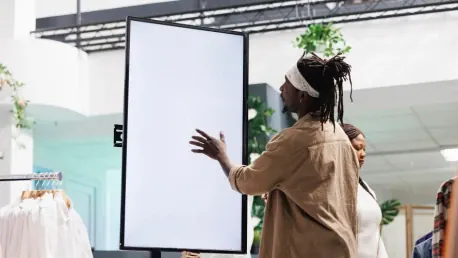The evolving landscape of shopper marketing is increasingly reliant on the integration of Retail Media and Out-Of-Home (OOH) advertising. These two elements are crucial for creating a comprehensive strategy that engages consumers throughout their purchasing journey. As retail environments become more sophisticated, a blended media approach that includes both in-store and out-of-store elements is essential.
The Role of Retail Media in Shopper Marketing
Leveraging First-Party Data for Targeting
Retail Media has gained prominence due to advances in customer data and innovative media solutions. By utilizing first-party data from loyalty programs, retailers can target consumers with unprecedented precision. This allows for accurate measurement of campaign impact through closed-loop reporting, enhancing the effectiveness of marketing efforts. The ability to harness data directly from consumer behaviors provides a granular understanding of shopper preferences and tendencies, which can then be translated into highly tailored marketing strategies.
With first-party data, retailers achieve unparalleled insights into individual consumer journeys. These insights enable brands to personalize their outreach and create more relevant content, which appeals directly to the interests and needs of their audience. By doing so, retailers not only increase engagement but also foster a stronger connection with their customers, leading to higher loyalty and repeat purchases. The precision targeting facilitated by Retail Media platforms allows for the efficient allocation of marketing resources, ensuring that every dollar spent produces measurable results.
Influence on In-Store Purchasing Behavior
Despite the rise of e-commerce, a significant portion of retail sales still occurs in physical stores. Retail Media plays a vital role in reaching consumers at these critical junctures. With a notable percentage of young consumers preferring in-store shopping, Retail Media has a unique advantage in influencing purchasing decisions within the store environment. This influence is not confined merely to attracting shoppers but extends to guiding their purchase decisions once they are inside the store.
In-store digital screens, targeted promotions, and interactive displays are just some of the tools Retail Media uses to capture attention and drive sales. By delivering compelling content that resonates with shoppers’ immediate needs, retailers can significantly impact purchasing decisions. Additionally, Retail Media allows for the real-time adaptation of in-store campaigns based on ongoing sales data and customer feedback. This flexibility ensures that the marketing approach remains relevant and effective, continuously engaging shoppers and driving them towards making a purchase.
The Power of OOH Advertising
Priming Consumers Before Store Entry
OOH advertising is highly effective in building brand awareness and mental availability before consumers enter a store. Statistics show that exposure to OOH ads significantly increases brand recall, making it a powerful tool for early-stage awareness in the shopper journey. By priming consumers with memorable and impactful messaging, OOH helps brands establish a strong presence in the consumer’s mind even before they step into a retail location.
The strategic placement of OOH ads in high-traffic areas serves as a constant reminder of the brand, ensuring that it remains top of mind. This early-stage priming effectively prepares consumers for subsequent encounters with the brand, whether through Retail Media within the store or digital ads on their devices. The seamless transition from out-of-home to in-store creates a cohesive brand experience that reinforces messaging and increases the likelihood of conversion.
Strategic Touchpoints for Enhanced Visibility
As consumers spend more time outside their homes, engaging in various activities, OOH advertising provides strategic touchpoints for brands. Whether driving, visiting shopping malls, or frequenting high street retail stores, these behaviors present opportunities to enhance brand visibility and drive in-store visits. The habitual nature of these activities means that consumers are regularly exposed to OOH campaigns, which in turn strengthens brand recognition and recall.
This continuous exposure not only keeps the brand in the consumer’s line of sight but also integrates it into their daily routines. This repetitive visibility helps build familiarity and trust, making consumers more receptive to in-store promotions and more likely to make a purchase. Furthermore, as OOH advertising evolves with advancements in digital technology, brands can now create dynamic and interactive experiences that captivate audiences and deepen engagement. By leveraging both traditional and modern OOH formats, brands can maximize their reach and ensure their message resonates across various consumer touchpoints.
Synergizing Retail Media and OOH
Creating a Seamless Omnichannel Experience
The integration of Retail Media and OOH creates a seamless, omnichannel experience that captures consumer attention at multiple touchpoints. This comprehensive approach is essential as the shopper journey becomes more intricate and multifaceted, requiring a blended media strategy to maintain engagement. By combining the strengths of both Retail Media and OOH, brands can deliver a unified message that guides consumers from initial awareness through to the final purchase decision.
This omnichannel strategy ensures that consumers receive consistent and cohesive messaging regardless of where they encounter the brand. Whether through outdoor billboards, in-store screens, or digital platforms, the synchronization of Retail Media and OOH keeps the brand experience fluid and interconnected. This synergy not only enhances consumer engagement but also maximizes the impact of marketing efforts, driving higher conversion rates and greater brand loyalty.
Real-Time, Contextually Relevant Advertising
Dynamic and programmatic OOH technologies allow for real-time, contextually relevant advertising. This capability ensures that ads resonate with consumers right before they make purchasing decisions, enhancing the influence of OOH as they move closer to the point of purchase. By using data-driven insights to adjust content in real-time, brands can deliver highly relevant and timely messages that align with the consumer’s current context and needs.
For example, a retailer might use real-time weather data to promote relevant products, such as advertising cold beverages on a hot day or umbrellas during a rainstorm. This contextual relevance makes the advertising more meaningful and impactful, increasing the likelihood of influencing purchase behavior. Additionally, programmatic OOH allows for greater flexibility in campaign execution, enabling brands to respond swiftly to changing market conditions and consumer preferences. This agility ensures that the advertising remains fresh, compelling, and effective, ultimately driving higher engagement and sales.
In-Store Media’s Impact on Conversion
Engaging Consumers Within the Store
In-store media has a profound impact on engaging consumers during their shopping experience. A significant percentage of consumers interact with in-store media, and many indicate that these ads influence their purchase decisions. This final opportunity to convert shopper intent into action is critical for driving conversions. By delivering targeted and engaging content right at the point of purchase, in-store media provides the nudge that consumers often need to make a buying decision.
Interactive screens, digital kiosks, and engaging displays can capture shopper attention and provide valuable information that aids in the decision-making process. Additionally, the use of personalized promotions and real-time offers can further incentivize purchases, making the shopping experience more enjoyable and rewarding for consumers. The strategic placement of in-store media ensures that the messaging is seen at the most opportune moments, maximizing its impact and effectiveness.
Adapting to Shopper Behaviors
The evolving landscape of shopper marketing increasingly depends on integrating Retail Media and Out-Of-Home (OOH) advertising. These elements are vital for crafting a cohesive strategy that keeps consumers engaged at every step of their buying journey. As retail environments grow more advanced and intricate, it’s clear that a blended media approach, combining both in-store and out-of-store components, is crucial. Retail Media involves advertisements that reach customers directly through various retail channels, enhancing their shopping experience by targeting them with relevant promotions. Concurrently, OOH advertising extends beyond the confines of the store, using billboards, transit ads, and digital signage to capture consumer attention in their everyday lives. By merging these elements, retailers can create a seamless and more engaging brand experience, effectively influencing purchasing decisions both inside and outside the store. The sophisticated interplay of these media ensures a consistent message, enhancing consumer connection and driving sales.









